‘Shaun of the Dead’ Oral History: Zombie Trust Exercises, Getting Egged on Set, and Helen Mirren’s Unforgettable Turndown

“Shaun of the Dead” remains, against the odds, one of the most successful British indie films of all time. Released in the early-noughties period when British indies were struggling, from a budget of a modest $6.1 million, Edgar Wright’s 2004 film earned $39 million at the box office and made household names of Simon Pegg and Nick Frost.
The film quickly garnered many famous fans, too, from Quentin Tarantino to Eli Roth, Stephen King to the godfather of zombies, George Romero, whose film “Dawn of the Dead” inspired Wright and Pegg. The film was beloved and became an instant cult classic and spawned the three-flavor Cornetto trilogy alongside “Hot Fuzz” and “The World’s End.”
More from IndieWire
The original idea came from an episode of “Spaced,” the UK sitcom written by Pegg and Jessica Hynes and directed by Wright that followed the lives of a group of housemates and their increasingly surreal lives. One episode, “Art,” saw Pegg’s character Tim stay up all night playing “Resident Evil” until he starts to hallucinate that zombies are invading his flat. It triggered an idea, and two years later, Wright and Pegg penned a script for “Shaun of the Dead,” and the first ever rom-zom-com went into production at Working Title.
The film was far from your average zombie horror, being a story fundamentally about friendship, love, growing up, moving on and finding connection in an increasingly lonely world. It was also rooted in autobiography, too — the off-screen friendship of Pegg, Wright, and Frost, the isolation of living in London and of humans struggling to cope in a post-9/11 world. The film’s legacy has endured, and this year, it’s getting a re-release in cinemas to celebrate its 20th anniversary.
IndieWire spoke to Edgar Wright, Simon Pegg (Shaun), Nick Frost (Ed), Dylan Moran (David), Kate Ashfield (Liz), Lucy Davis (Dianne), and Penelope Wilton (Barbara) about “Shaun of the Dead.”
This interview has been edited for clarity and length.
IndieWire: How did the idea for “Shaun of the Dead” emerge?
Simon Pegg: Edgar and I shot the zombie sequence for “Spaced,” and we both remarked afterwards that we should make a zombie movie because it was so much fun. We thought it would be easy to do. We were powered by naïveté in those days. We thought we could do anything!
Edgar Wright: We were so high from doing that sequence. I remember being in a cab with Simon on the way home, and we started talking about how we should do a whole movie of that.
Nick Frost: I was always around when Edgar and Simon were writing it. I remember reading a draft and offering little suggestions where I could. During rehearsals, sometimes funny things would come from me and Simon improvising that were added to the shooting script.
Wright: We liked the idea of doing a zombie film that wasn’t first and foremost about the zombies. We show a zombie apocalypse through one character’s experience as he’s going through his own quarter-life crisis: a perpetual adolescent whose life is starting to unravel.
Kate Ashfield: The script wasn’t like anything else I’d read before: I thought it would be a great cult movie because of how off-the-wall it was. Edgar was so well prepared and referenced so many other films — he was a real geek! I think his brother did the storyboards — everything was drawn out and planned so clearly. They knew exactly what they were going to do.
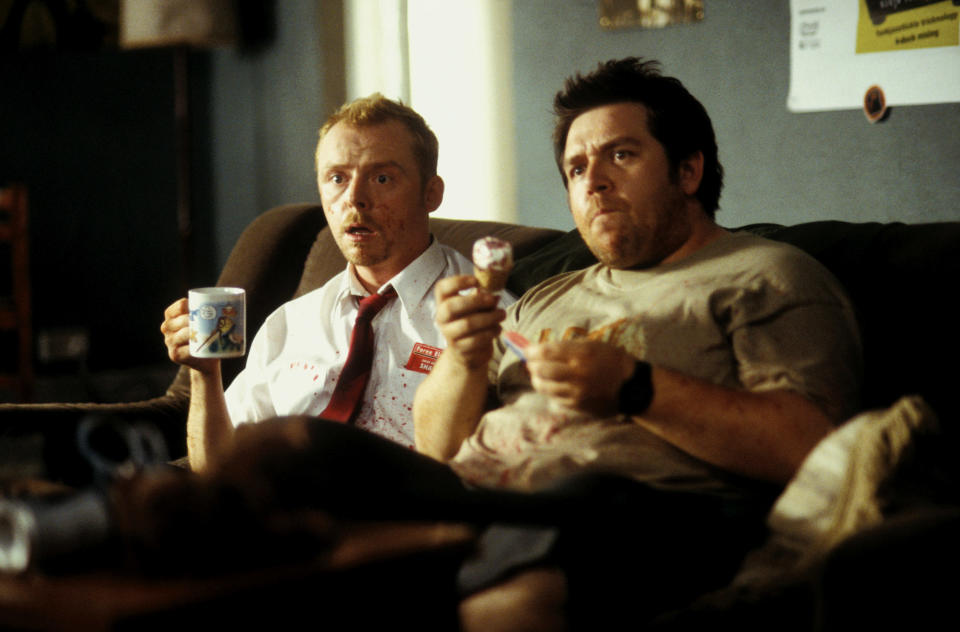
What are your memories about the first few days of filming?
Pegg: On day one, we filmed Shaun’s walk to the shop pre- and post-zombie invasion. I think Edgar wanted to lay out his stall for the crew to understand what we were trying to do.
Wright: I had a discussion with my director of photography who was convinced the long scene of Shaun going to the shop was “shoe leather” — meaning it was boring and was going to be cut. After he said that, whatever detail had been in that shot tripled. I wanted to make a shot that was so cool, so amazing it was impossible to cut it. I felt compelled to prove it was worth doing. I was really happy that not only did it make it into the film, but it’s still the shot people always talk about.
Penelope Wilton: They really hammered on and got it made with a very small budget. Edgar had challenges but always stuck to what he wanted. You have to do that. Otherwise, you’ll just end up giving in to an older crew, and it’s not what you want in the end. He was very clever and brave to do that because if you’re a young man up against all that experience, they think, “Oh, he’s young, and he’s a whippersnapper.” Well, he certainly wasn’t! He’s always been very assured and I’m not surprised he’s had such a marvelous career.
Pegg: I think it was hard for Edgar to be taken seriously by his crew at first because they assumed he was just some punk kid. Many people thought the film would go straight to video. An extra said that to Edgar, not realizing he was the director. But he was so assured and certain in terms of what he wanted to do that eventually, they all respected him and understood.
You filmed the garden scene next with the zombies.
Pegg: We had a kind of a trust exercise with two zombies, The Hulk and Mary, the first zombies Shaun and Ed encounter. We basically had to throw these soft, rubber objects at their heads to get them used to us throwing things at them. We were trying to teach them not to blink, which was silly, it’s not something you have any choice over!
Frost: They basically stood there in stunt rehearsals and we threw things at their faces. As a human being, I really didn’t want to throw a rubber biscuit tin in a woman’s face. They had to learn how to be pounded in the face by these things, without showing any reaction whatsoever, which was really difficult. I mean it was kind of enjoyable, but I was also like, “These poor people!”
Wright: Taking somebody’s blinks away digitally then was more complicated than now. We had a big thing about zombies not blinking because they’re impervious to pain. We used rubber frisbees for records to rehearse. All five of us did the trust exercises with various flying objects, which was really very silly. I’d like to apologize to everybody!
Fans of “Spaced” played a big part in the film, too.
Wright: Yes, we put the word out to “Spaced” fans and asked them to come and be zombies for us. Without them, we couldn’t have pulled it off.
Wilton: People were very happy to play zombies because it’s everybody’s dream: They just loved playing them. My daughter was in her late teens when I made that film and my street cred went up because I turned into a zombie. Her friends asked if I might go and have supper with them with my zombie eyes in. I said certainly not!
Didn’t one of the zombies you worked with take things a bit too far?
Wright: We were taking a sound recording because we needed zombie noise, just audio only. I was sort of conducting them, and in one take, I said, “OK, come in and attack me!” And of course, they all did and maybe because they felt so cooped up — they’d been on set waiting to be used for days – one of them came at me and bit my leg. The camera’s not even running but he goes straight down and he bites my leg. He was really method: he’d gone deep! I think the zombies had gone feral!
Lucy Davis: I have a video where we’re outside The Winchester and Edgar is on this big platform, and he was like a conductor of a giant zombie orchestra. He was conducting them making zombie noises — from low “urrrrghhhs” to huge “grrrrs!”
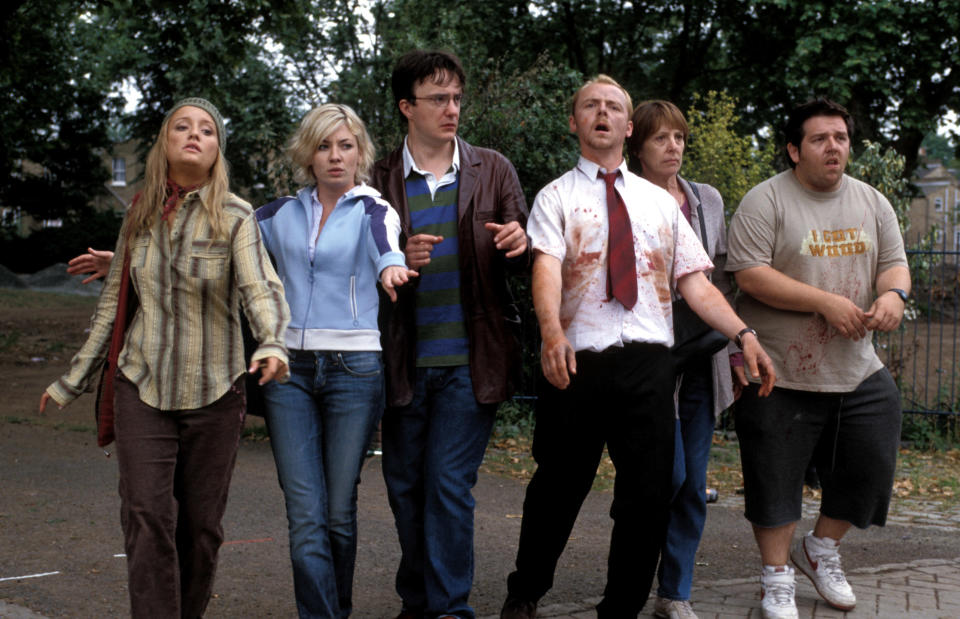
You also had some issues when filming around London with some teenagers.
Wright: There was a group of disgruntled teenagers who were throwing stones at the camera because we were on their turf.
Frost: We got egged a lot. We needed some local tough nuts to be our security.
Wright: In an attempt to make peace with the teenagers, we promised that they could be in the film. A couple of days later, they went through makeup, dressed up as zombies and they’re in the film — you can see them when Shaun is next to the garden fence!
The record-throwing scene is regarded as one of the film’s funniest. How was this made?
Wright: I remember the idea of using vinyl as a weapon first came to me because a friend of mine in the West Country used to throw charity shop records at a tree and try and make the record stick in the tree and not shatter. I do not recommend this! But that’s what gave me the idea.
Originally, we planned to throw David Bowie records instead of Prince ones. It was like, “‘Hunky Dory’? No! ‘Ziggy Stardust’? No! The ‘Labyrinth’ soundtrack? Yes!’” I love David Bowie and Prince equally, but for some reason, the Prince gag was funnier. “‘The Batman’ soundtrack? Throw it!” We needed permission from artists to show the album artwork. Sade immediately signed a release form to have her album shattered against a zombie’s head: She will forever be the coolest. Simon wrote a letter to Mark Knopfler trying to convince him we were paying tribute to Dire Straits, even though we were trashing his record. He didn’t reply!
What are some of your other memories from the set?
Dylan Moran: The scene with all the zombies in the pub was quite disorientating for me as I was on my back for most of it, looking up as they tore me apart. I was pulled around quite a lot and that went on for hours! I vividly remember all the crowds, the extras and the zombie twins. There was something really funny about the zombies wearing modern clothes.
Penelope Wilton: He was very nice, Dylan. He used to go out during the lunch break and go into second-hand book shops and buy books for us to read. He got me one, I remember. We all got on very well; it was a very happy shoot. I was a bit older than everyone else and it was lovely to have that energy: They were all very sweet to me.
Ashfield: It was always such a fun project to film, just seeing zombies everywhere on the suburban streets in London and people coming out of their houses to see what the hell was going on. I remember seeing Bill [Nighy] covered in thick, sticky treacle-y blood. I said: “Oh Bill, how horrible!” He was just like, “But what a way to earn a living!” He was absolutely right. The whole thing was such fun from start to end.
Wilton: My contribution was to the imaginary dream sequences in the film, when we’re running away from Liz’s flat and to Philip’s jaguar. Shaun is imagining getting away very easily but of course, it’s much harder than that. They suggested running across the grass but I said, “Let’s join hands and skip instead,” because it was a sort of fantasy moment. We all joined hands and skipped across the lawn which made me laugh — and it made the final film.
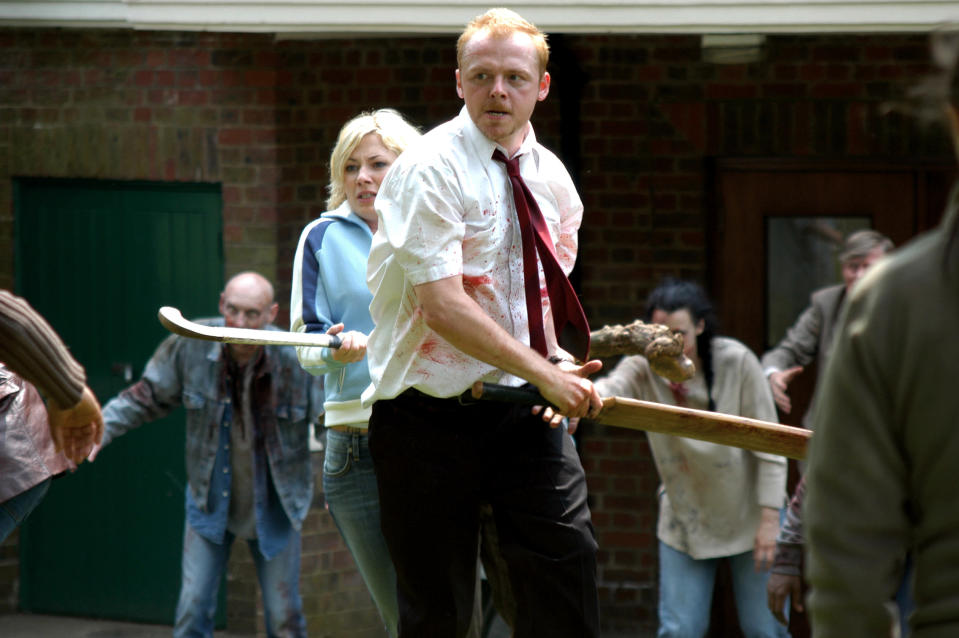
Frost: Driving the Jaguar with Bill was something. It was the first time I’d driven an old jag. At one point, we were on a giant turntable that just spun the car ’round in the middle of the street.
Davis: I think we filmed the car scene over four days. I was sitting on Dylan’s lap in the car and we were next to Simon, who was next to Bill. Penelope had Kate on her lap, Nick was driving, and I remember there were times when we’d been in there so long, we lost feeling in our legs. There were times we just talked and talked, other times we sang, and other times were just complete silence. One day, Bill just spontaneously burst into song for no reason, and we pissed ourselves.
Ashfield: Nick used to do Al Pacino impressions in between takes which would make us all laugh.
Davis: I loved the day when we met our doppelgängers on set, especially Martin Freeman, who I knew from “The Office,” which we were in together at the time.
Were there any scenes that were cut?
Pegg: There’s some deleted scenes. We wanted them to come across a crashed airplane on the way to The Winchester, but it was just too expensive to do. When Edgar and I saw Steven Spielberg’s “War of the Worlds,” and there’s a scene with Tom Cruise and a plane crash we were like, “This was our idea!”
Ashfield: A motorcycle courier zombie was supposed to come at me at one point. I was going to get thrown a gun where I then flip it round and fire through the helmet and then flip it back again to which Shaun replies, “Smooth.” I really wanted to do that!
Quite a lot of the film referenced your own lives.
Frost: Simon and I lived together and we would always sit in the pub, drinking and wondering what we’d do if there was a zombie invasion.
Pegg: Our local was an old man pub. Nick and I spent so much time there we became ensconced. We used to give the regulars nicknames and invent little histories for them. That made it directly into the movie when Ed’s trying to cheer Shaun up. If there was a zombie apocalypse, we’d decided we’d go to this pub. It had big heavy doors. There were lock-ins every weekend. You could never tell if anyone was inside.
Wright: I remember I promised my girlfriend at the time I wouldn’t stay up all night playing “Resident Evil 3,” but I ended up playing it until 5 in the morning. The sun came up, and I walked across the street to the newsagents on a Sunday to get some milk. I was taken with how completely deserted the streets were. I started thinking: what if there were zombies out now? What would I do as a British person? In video games and American films, everybody’s got weapons, but as a Brit where there are no guns around, what do you do? Obviously use things in the house like a cricket bat being the most British of these. That was something to me that was a real flash point scene idea, and then from that, I think we started to formulate exactly what it was.
Pegg: The scene with Shaun and Philip in the back of the car was a strange cathartic reimagining of my own relationship with my stepfather. The things Philip said in the car were what I wished were the truth about my relationship with my stepfather, which was a bit more problematic. Playing that moment was like psychotherapy for me. I’m still friends with Bill; he’s been hugely supportive since I’ve gone into recovery having been through that himself.
Wright: A lot of it came from living in the city, too. It’s very easy in a metropolis like London to be in the busiest place on earth and yet feel completely alone at the same time.
Pegg: It is a metaphor about living in the city, about stepping over homeless people and how anonymous, introverted and self-consumed you can be in a city. You can be surrounded by millions of people and never speak to anyone. As human beings who live communally, we’re also very antisocial at times. The idea that Shaun could walk to work and not notice that a zombie apocalypse felt very funny to us because it was kind of based entirely in truth.
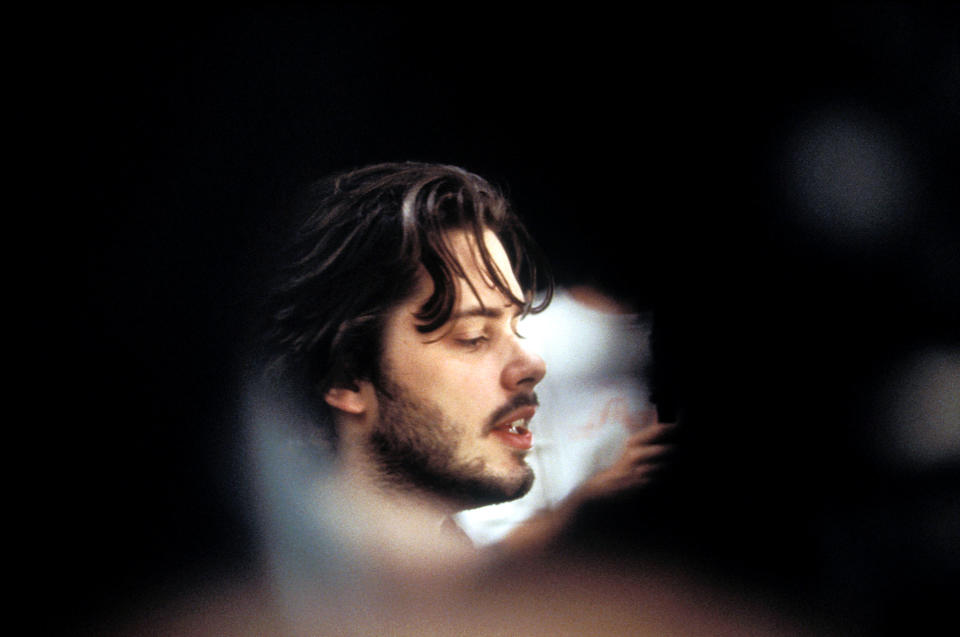
Moran: There was definitely reference to there not being any belief system in the UK at that time, of there being nothing holding people together. People were just materialistically going through the motions of their lives without being very invested in it.
Wright: We finished writing the script on 9/11, and I remember being in London and seeing people’s faces who were either as anxiety-ridden and distressed as I was, or seeing people who either didn’t know or didn’t care all existing in the same place. It was an incredibly surreal day. We’d finished the script, but it was sort of confirmation of how, in a crisis, life doesn’t stop, which is what we’d written about in the script.
The studio had some casting suggestions for you.
Wright: Yes, we were asked to look at “casting up” in the roles of Liz and Barbara even though we’d written those for Kate Ashfield and Penelope Wilton. We met Kate Winslet about playing Liz and she liked it, but ultimately didn’t do it. Bill Nighy came in because he’d just made “Love Actually” for Working Title. Bill totally got the script on the first read.
Pegg: We’d all sit around in Bill’s trailer, and he’d just tell us stories about his renegade days in Paris. We were all mesmerized. He’d often blast The Rolling Stones.
Wright: I’m not sure Bill was entirely happy about his costume. He does like to look dapper, but for this, he had to look like a suburban stepdad: Bill loved making the film but scoured about how boring he looked!
Wilton: Bill is a very smart dresser. He didn’t even like to wear a T-shirt in the summer out in India when we were filming “The Best Exotic Marigold Hotel.” He’d always wear a smart, long-sleeved shirt.
Wright: The studio asked us to go to Helen Mirren [for Barbara], and she replied with a letter. She said, “I love the script, but if I was going to do it, I’d want to play the character of Ed because he has the funniest lines!” As passes go, I really admired it! It came back around to Penelope who we always wanted. She passed at first, but we asked her agents if we could take her out to tea. She met us and came on board.
Wilton: I got the script and to be quite honest with you, I couldn’t make head nor tail of it. I met Simon, Edgar and Nick because I thought they could explain it to me. They were absolutely charming. They explained it to me, but I still didn’t understand. They were so nice though, I thought “I’m going to do this anyhow.” It all became clear what they were doing once I started seeing the storyboards.
Moran: Bill was very nice, funny, stylish and suave always just by being himself. I remember just watching Penelope and thinking, “That’s what acting is.” She was amazing to watch.
Wilton: Oh, I don’t believe any of that. I think they were all very good at what they did straight away!
Wright: There was some talk of not having Nick because he hadn’t done much beyond “Spaced,” but that was a deal breaker for us. We came as a package.
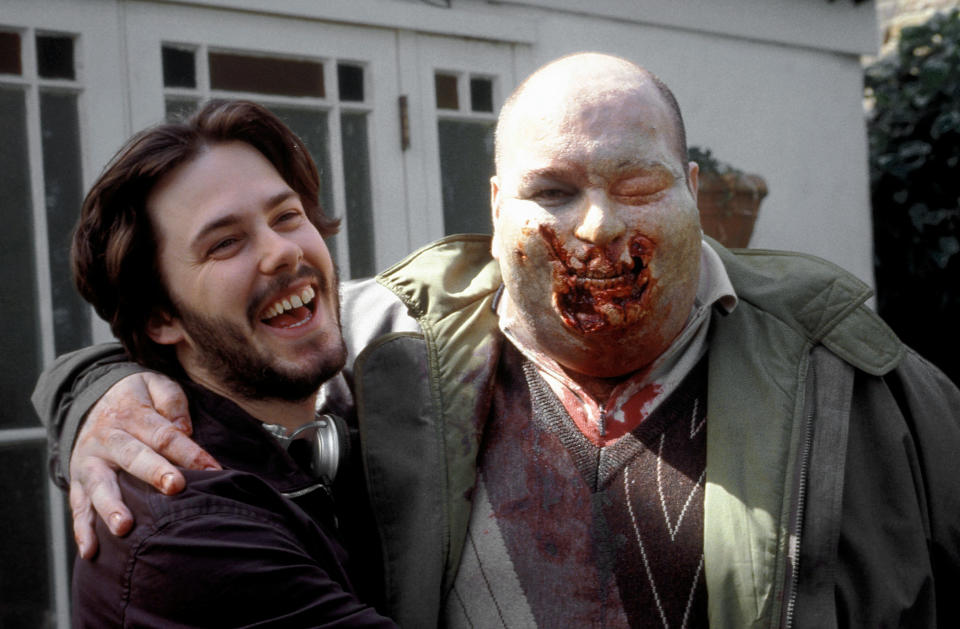
Frost: I never really wanted to act. I just happened to act in “Spaced” because Simon and Jess wrote me a part in it and Edgar was good enough to have some weird trust in the fact I could do it. I had a feeling I just didn’t really belong and I was going to get caught out. Having to act with people like Bill and Penelope: I was just terrified. Fortunately, I had Edgar and Simon there to help me.
Ashfield: I think they had to fight to get me because as soon as the money came, they wanted Rachel Weisz or Kate Winslet. But Edgar and Simon had ideas from the get-go about the cast: they wanted it to be quite ordinary people.
The Winchester film is the scene’s climax: what was it like bringing this together?
Wright: The Winchester scene was a tough stretch. I really remember the poor zombies who’d been outside for days waiting to be used. When they eventually stormed in, it felt like a real release for everybody: it was really electric shooting those scenes. It felt like it was really happening!
Pegg: Edgar chose the Queen song. He had this idea of us beating a zombie to death to a really upbeat tune. He’s always been really interested in diegetic sound, so the actors responding to noises within the film and you can see the progression from this to “Baby Driver.” We wrote a letter to Brian May basically begging him to use it and asking that he wouldn’t charge us through the roof: he was really lovely about it.
The guy who played the landlord in the pub was a 70-year-old stunt man. He’d been in “Branigan” and actually had a fight with John Wayne on screen! He gets thrown into a jukebox in Brannigan as well.
Frost: He got fucking battered for like two days!
Pegg: He was such a good sport. He was padded up, but he was like, “You’ve got to really hit me!” And I was like, “But you’re 70, Steve!” He was so game.
Wilton: Sometimes you do a film, and you have a very good time. They don’t always work out, those films, because you’re enjoying it too much. But Edgar is quite strict and he’ll keep on doing it until he gets exactly what he wants. We did things time and time again — like the landlord of the pub being hit by those snooker cues. We did that for ages, but it worked out brilliantly.
Davis: We’d just done the scene where we pretend to be zombies and Dylan has to smash a bin through a window, but he accidentally did that during rehearsal not realizing he was meant to wait! The crew shouted at him.
Moran: My character absolutely got what he deserved when he was disemboweled. David was dweeby and officious, the weak link in the group and a complete technocrat. You know where he’d be right now? In the current UK government.
Davis: Dylan had to be half-out of a window in the pub with this prosthetic on top of his stomach that the zombies could tear into. That day, my mum was filling in as a zombie. She got right in there with Dylan’s innards and really went for it!
Wilton: I had to go to an optician to have my zombie lenses specially made. They never left them in my eyes for too long because they were quite uncomfortable. I had a prosthetic arm on, too, which was wrapped round my arm. It all took a lot of time because they were so diligent about getting it right.
Pegg: I hated having to shoot Barbara, my mum. Whenever there’s a moment of genuine drama or seriousness — and this goes for the whole of the Cornetto Trilogy — those moments of tragedy are played straight. They’re never played for laughs; there’s no wink at the camera.
Frost: When you start weaving truth and emotion in there and things that humans can identify with and once you start to feel like it talks to you as a human, that’s when people get hooked.
Wilton: Edgar said I wasn’t to do [much] acting in this scene. It made him too upset! I had to turn into a zombie lying down at first, but I think he cut quite a lot of that. But you know, I really went for it because it was my only chance to turn into a zombie. I also had a wonderful prosthetic arm with an awful bite in it which was terribly clever; the makeup and special effects were quite brilliant.
Pegg: The death of Barbara was a long day; we were sobbing all day. Penelope actually looks like my mum too. Nick and I went into a room outside and began properly crying because we were just so exhausted emotionally and, of course, Barbara’s death is so tragic. It broke our hearts.
Wilton: I met Simon’s mother. There is a similarity between us. I was busy doing the acting, and they were busy being upset!
Davis: I remember doing the dart-throwing scene: I was sure I was going to hit Simon. I remember standing behind Simon when he was shooting the rifle, and one of the blanks landed on my cheek: I had a scar for years!
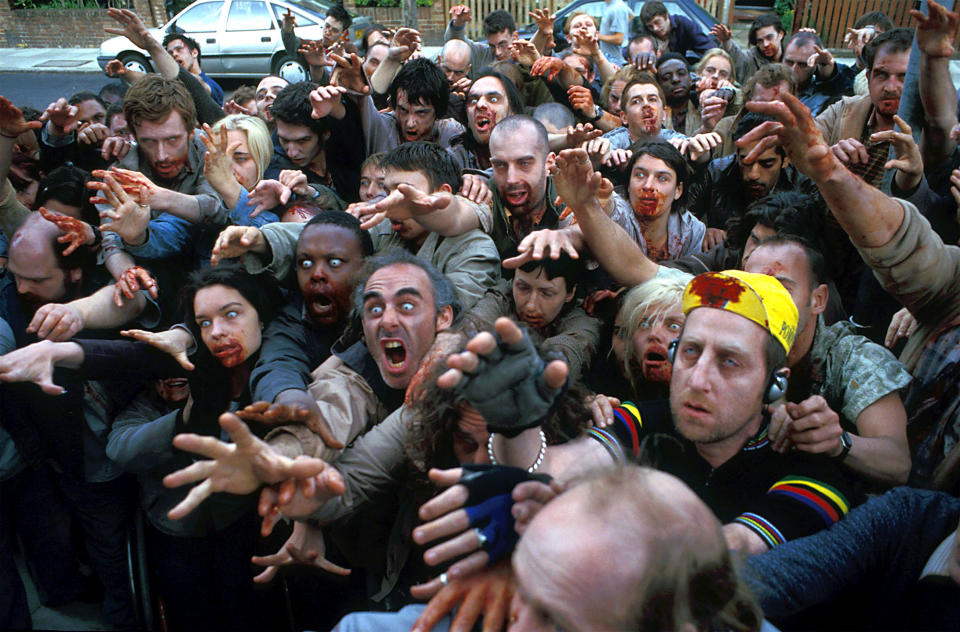
The film was a smash at the box office both here and abroad: What are your memories of that time?
Pegg: When the film came out, our poster had quotes from Stephen King, Peter Jackson, Eli Roth, Quentin Tarantino. It was an incredible swell of support from people we’d grown up admiring. And now, 20 years later, it’s still talked about.
Wright: We screened the film for George Romero.
Pegg: Universal sent a security guard with the film, which was hilarious to Edgar and me because it was like, “Are you worried that George is going to steal the film that we basically stole from him?!”
Wright: Simon and I both got calls from George. Suddenly, the world got smaller. It was so exciting but also really profound in terms of “oh, look what happened.” We made a movie in honor of this director and now he’s calling us to tell us how much he liked it. It was just mind-blowing.
Everybody that gave a quote for the poster, we gave them one of Shaun’s name badges, which we had specially made. When we met George for the first time in person, he was wearing his. We sent one to Stephen King. Later, on email, I asked him if he ever got his badge. “Not only did I get the badge Edgar, I’m wearing it right now!” he replied.
Frost: It was such a special experience, and we’ve managed to remain friends for 30 years. We still love each other as much now as then.
Wilton: I would work with them again tomorrow because it was such fun. A lot of filming is waltzing with a camera. Edgar did that terribly well. I can’t wait for the re-release of the film in cinemas this year.
Wright: Seeing a print ad for the film with a list of cinemas at the bottom was really profound for me. I still never take anything for granted in this industry and I didn’t then either. I felt incredibly fortunate to have made the movie I wanted to make with very little compromise. It was an amazing year, probably the best year of my life.
Best of IndieWire
The 22 Best Spy Movies, from 'Enemy of the State' to 'North by Northwest'
The 12 Best Thrillers Streaming on Netflix in April, from 'Fair Play' to 'Emily the Criminal'
Quentin Tarantino's Favorite Movies: 61 Films the Director Wants You to See
Sign up for Indiewire's Newsletter. For the latest news, follow us on Facebook, Twitter, and Instagram.

